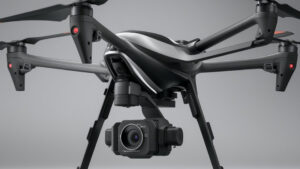Have you ever wondered how radiation detectors keep you safe? When you’re near a medical facility or a nuclear power plant, these devices play a crucial role.
Recommended Best Product in 2025
| Recommendation | Product |
| Best Overall | Nuclear Radiation Detector GQ GMC-800 |
| Popular Choice | ERICKHILL EMF Meter |
| Best Value | TESMEN EMF Meter |
| Best Budget | Ywcking Rechargeable Radiation detector |
| Another Excellent Pick | Geiger Counter Nuclear Radiation Detector |
They quietly monitor the environment, ensuring that radiation levels remain safe for you and your loved ones. Understanding how these detectors work can be both fascinating and reassuring. Imagine having the power to see the invisible. Radiation, unlike light or sound, cannot be detected by human senses.
So, how do these detectors spot it? This article will unravel the mystery behind how radiation detectors work, explaining the technology that helps protect you every day. By the end, you’ll not only understand the science but also appreciate the peace of mind these devices provide. Dive in, and discover the hidden world that radiation detectors reveal just for you.
Types Of Radiation
Radiation is all around us, part of our daily environment. Understanding its types is crucial for safety. This section will cover two primary categories of radiation. Each has unique characteristics and sources.
Ionizing And Non-ionizing Radiation
Ionizing radiation carries enough energy to remove tightly bound electrons. This process can damage living tissue. Examples include X-rays and gamma rays. Non-ionizing radiation lacks this energy. It does not ionize atoms. Examples are radio waves and microwaves. Both types are common in various applications.
Common Sources Of Radiation
Radiation comes from both natural and human-made sources. Natural sources include cosmic rays from space. Earth itself emits radiation, such as radon gas. Human-made sources often involve medical uses. X-rays in hospitals are a familiar example. Nuclear power plants also emit radiation. Everyday devices like microwaves and cell phones emit non-ionizing radiation. Understanding these sources helps manage exposure.
Principles Of Radiation Detection
Radiation detection plays a crucial role in safety and scientific research. Understanding the principles behind these detectors helps us appreciate their importance. Radiation detectors identify and measure ionizing radiation. They rely on interactions between radiation and matter. These interactions are key to detecting radiation accurately.
Interaction With Matter
Radiation interacts with matter in different ways. It can excite, ionize, or scatter particles in a material. These interactions vary based on the type of radiation and material. Alpha particles lose energy quickly in matter. Beta particles can penetrate further but still cause ionization. Gamma rays are highly penetrating and require dense materials to stop them. The nature of these interactions helps detectors measure radiation.
Detection Mechanisms
Detection mechanisms convert radiation interactions into measurable signals. Many detectors use gases or solids to capture radiation events. Geiger-Müller tubes are common gas-filled detectors. They detect radiation by ionizing the gas inside. Solid-state detectors use materials like silicon. They register radiation through electron-hole pairs. Scintillation detectors use special crystals. These crystals emit light when struck by radiation. Photomultiplier tubes amplify this light into electrical signals.
Each detection method has its strengths and weaknesses. The choice depends on the type of radiation and required sensitivity. Understanding these principles is key to effective radiation monitoring.
Components Of A Radiation Detector
Understanding the components of a radiation detector helps in grasping its functionality. These devices are essential in monitoring radiation levels for safety and research. Each component plays a crucial role in detecting and processing radiation signals. Below, we explore key elements that make radiation detectors effective.
Sensor Technologies
Sensors are the heart of radiation detectors. They capture radiation particles and convert them into readable signals. Different sensor technologies cater to various radiation types. Geiger-Müller tubes are popular for detecting alpha and beta particles. Scintillation detectors use crystals to detect gamma rays. Semiconductor detectors are ideal for precise measurements. Each type offers distinct advantages in specific environments.
Data Processing Systems
Data processing systems analyze the signals from sensors. They convert raw data into meaningful information. Microprocessors handle calculations and data filtering. This ensures accurate radiation readings. Software systems display data in a user-friendly format. Digital interfaces allow easy interpretation of results. These systems are vital for real-time monitoring and decision-making.
Popular Radiation Detection Methods
Radiation detection is essential for safety in various fields. It ensures environments and equipment remain safe from harmful radiation. Different methods are employed to detect radiation effectively. Understanding these methods helps grasp how radiation detectors operate.
Geiger-müller Counters
Geiger-Müller counters are popular due to their simplicity. They detect ionizing radiation like alpha, beta, and gamma rays. A Geiger-Müller tube filled with gas is central to its operation. Radiation enters the tube and ionizes the gas. This ionization creates an electric pulse. The device counts these pulses, indicating radiation levels. Geiger counters are portable and easy to use. They are ideal for quick radiation surveys.
Scintillation Detectors
Scintillation detectors use scintillating materials to detect radiation. When radiation hits these materials, they emit light. Photomultiplier tubes then convert this light into an electric signal. This signal measures the radiation’s energy and intensity. Scintillation detectors are sensitive and accurate. They are suitable for detecting low-level radiation. They are often used in medical imaging and nuclear research.
Semiconductor Detectors
Semiconductor detectors utilize semiconductor materials like silicon or germanium. Radiation interacts with the semiconductor, creating electron-hole pairs. This interaction generates a measurable electric signal. Semiconductor detectors provide precise energy measurements. They are effective in high-resolution spectroscopy. They are commonly used in research labs and for environmental monitoring.
Applications Of Radiation Detectors
Radiation detectors identify energy released from radioactive materials. They measure ionization levels in the air, converting this data into readable information. Used in medical imaging, environmental monitoring, and nuclear safety, these detectors provide crucial insights by interpreting radiation levels, ensuring safety and accuracy in various applications.
Radiation detectors play a crucial role in various fields by identifying and measuring radiation levels. Their applications span across healthcare, environmental safety, and industry. Understanding how these detectors work can open your eyes to the hidden layers of technology that keep us safe and informed every day.
Medical Imaging
In the medical world, radiation detectors are essential for diagnostic tools like X-rays and CT scans. These detectors convert radiation into images, allowing doctors to see inside your body without invasive surgery. This technology not only speeds up diagnosis but also enhances accuracy, potentially saving lives.
Imagine walking into a hospital where doctors can pinpoint an issue swiftly, thanks to detailed images created by radiation detectors. This precision ensures you receive the right treatment at the right time. Next time you have an X-ray, remember the hidden technology that makes it all possible.
Environmental Monitoring
Radiation detectors help keep our environment safe by measuring radiation levels in air, water, and soil. They are vital for monitoring areas around nuclear power plants and detecting any potential leaks.
Think about the peace of mind knowing your local environment is being continually assessed for radiation safety. Detectors can alert authorities to take action before radiation reaches harmful levels. This proactive approach protects you and your community from unseen dangers.
###
Industrial Uses
In industries, radiation detectors are used to ensure safety and improve processes. They help in gauging thickness in paper production, checking welds in pipelines, and even in mining for locating minerals.
Consider the efficiency boost when a manufacturing plant uses radiation detectors to maintain quality control. This precision not only saves materials but also enhances product reliability. Industries rely on these detectors to keep operations running smoothly and safely.
Radiation detectors may seem like a complex piece of technology, but they are woven into the fabric of everyday life in ways you might not have realized. How might understanding these applications change your perspective on the world around you?
Challenges In Radiation Detection
Detecting radiation is crucial for safety and environmental monitoring. Challenges often arise in the process of radiation detection. These challenges can affect the accuracy and reliability of the measurements. Understanding these challenges helps in improving the performance of radiation detectors.
Sensitivity And Accuracy
Sensitivity refers to a detector’s ability to identify low levels of radiation. High sensitivity is important for detecting weak radiation signals. Accuracy ensures the detected radiation levels are correct. Factors like temperature and pressure can influence these aspects. A sensitive detector might pick up background noise, affecting accuracy. Balancing sensitivity and accuracy is key to effective radiation detection.
Calibration And Maintenance
Regular calibration ensures detectors provide accurate readings. This process involves comparing the detector’s measurements with known standards. Calibration helps in correcting any deviations from expected readings. Maintenance is equally important to keep detectors functioning well. Dust or dirt can affect the detector’s performance. Regular cleaning and checking are necessary to prevent malfunctions. Both calibration and maintenance require skilled personnel to ensure effective operation.
Future Innovations
Radiation detectors have come a long way since their inception. As technology advances, these devices are becoming more precise, efficient, and versatile. The future holds exciting possibilities for radiation detection, promising groundbreaking innovations that could reshape industries and improve safety worldwide. Have you ever wondered what the next generation of radiation detectors might look like? Let’s dive into the potential advancements and new applications that could be on the horizon.
Advancements In Technology
Technological advancements are driving the evolution of radiation detectors. Imagine detectors that can provide real-time data with enhanced sensitivity. Innovations like quantum sensors and nanotechnology could soon make this a reality. These technologies have the potential to revolutionize how we measure and monitor radiation levels.
Consider the impact of integrating AI with radiation detectors. This could lead to smarter systems that automatically adjust to varying radiation levels and environments. Such advancements would not only enhance accuracy but also improve safety protocols significantly.
Your smartphone might soon be capable of detecting radiation. With miniaturization of technology, portable detectors could become commonplace. This means you could have a reliable radiation detector in your pocket, ready to use whenever needed.
Potential New Applications
With improved technology, radiation detectors could find new uses beyond traditional fields. Think about medical diagnostics where precise radiation measurement is crucial. Enhanced detectors could lead to more accurate imaging techniques, benefiting patients with better care.
Have you considered the role of radiation detectors in environmental monitoring? Detecting radiation levels in remote areas could become more feasible, aiding in conservation efforts and disaster prevention. This could be a game-changer for environmental scientists and policy makers.
Innovations might also extend to consumer safety. Radiation detectors could be integrated into household devices, ensuring safe levels in everyday environments. Wouldn’t it be reassuring to know your home appliances are safeguarding your health?
As you ponder these possibilities, think about how these advancements might affect your life and work. What future innovations would you like to see in radiation detection technology? The possibilities are vast and exciting, offering a glimpse into a safer and more efficient future.

Frequently Asked Questions
How Do Radiation Scanners Work?
Radiation scanners detect radiation levels using sensors. They measure gamma rays or X-rays emitted by objects. Scanners produce images by analyzing radiation patterns. They help identify harmful substances or concealed items. Advanced scanners provide detailed, real-time data for security and safety purposes.
What Is The Basic Principle Of Radiation Detector?
Radiation detectors identify and measure ionizing radiation by detecting charged particles produced during interaction with matter. They convert radiation energy into electrical signals, allowing precise measurement and analysis. These instruments are vital in medical, scientific, and industrial applications, ensuring safety and accurate detection of radiation levels.
What Can Set Off A Radiation Detector?
Radiation detectors can be triggered by medical isotopes, cosmic rays, nuclear materials, and industrial radiography sources. Environmental factors like radon gas or contaminated objects may also cause activation. High-energy particles from space can affect detector sensitivity, leading to false alarms.
Proper calibration ensures accurate readings and minimizes unnecessary alerts.
What Is The Difference Between A Geiger Counter And A Radiation Detector?
A Geiger counter specifically detects ionizing radiation using a Geiger-Müller tube. A radiation detector encompasses various devices, including Geiger counters, scintillation detectors, and dosimeters, to measure radiation levels. Each type uses different technology for detection and measurement.
Conclusion
Radiation detectors play a vital role in safety. They detect harmful radiation levels. Understanding their function helps you stay informed. These devices use sensors to identify radiation particles. They alert users to potential dangers. Knowing how they work enhances safety measures.
It’s essential for everyone, from scientists to the public. Awareness can prevent accidents. Investing time to learn about detectors is worthwhile. It ensures preparedness in radiation-prone areas. Stay safe, stay informed, and utilize these devices effectively. Embrace knowledge about radiation detection for a safer world.








